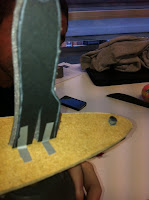Introduction:
The first lecture provided a simple overview of the project at hand as well as my first dose of interaction design theory, in particular, notes on the 'input/output' process. Post-lecture, we formed groups and completed a simple exercise relating to lecture content. This blog post will be fairly formal just so I make sure I can get through the required content. Future posts will be less rigid.Firstly, I'd like to introduce my team members. This team is a well balanced unit which will deliver quality design work
David Buchanan
A keen young designer, David's strengths include design thinking and digital visualisation, using tools such as Photoshop and Illustrator.
link to Dave's Blog:
Phillip Pappas
Often a fiery customer, Phillip's strengths include an attention to detail second-to-none and an incredible knowledge of new and emerging technologies.
link to Phil's Blog
Nick Kallinicos
An unofficial team captain, Nick's strengths include Computer Aided Design and an outstanding presentation style.
link to Nick's blog:
Personally, I can bring an enthusiasm for Manufacturing Technology and CAD as well as a willingness to pursue 'out of the box ideas'....
Key Lecture Content:
The key thought to come out of the lecture content included the requirement for designers to never think of a product in isolation. (note: although we had been taught this previously, this was the first time it had been explicitly stated). A product always sits within a system, amongst people and must adapt to people's behaviours.
Or... as below.
The Task:
From an initial, brief observation of the brief, the task revolves around designing a device that can easily transmit or receive news.We also have to do so using an Ardrino Kit.
At first glance, this project seems incredibly interesting, basically because it will be actually realising a thought.
Group Exploration Exercise:
After the lecture, we tried to develop an early understanding the the Input/Output concept. we did this through a simple brainstorming and model making exercise.The task involved brainstorming ways we could communicate information to people with the use of images or text as well as explore what we understood to mean by "input and output'
Or as below.....
After brainstorming and listing a whole series of ideas we came up with a concept for a situation that would require information to be transmitted, received and comprehended easily. The team liked the idea of a surf life saving device that could be attached to a surf lifesaving board. The device could transmit water and weather conditions instantly back to the beach and inform beach goers of the beach conditions.
Below is the model we made:
The model depicts sensors on either side of the surfboard which will then transmit information back to a screen on the beach. Colour symbols will be used to depict beach conditions.
Evaluation:
After making the model and explaining the concept to tutors, we were urged to expand our ideas.
"Who Else Could Harness this Information?"
Therefore, we believed the same technology could be used to get real time climate conditions all over the country, predict patterns, aid climatologists as well as track and monitor the local ecosystem and the health of flora and fauna.
The question above allowed us to vastly expand our horizons and idea generation process.











No comments:
Post a Comment